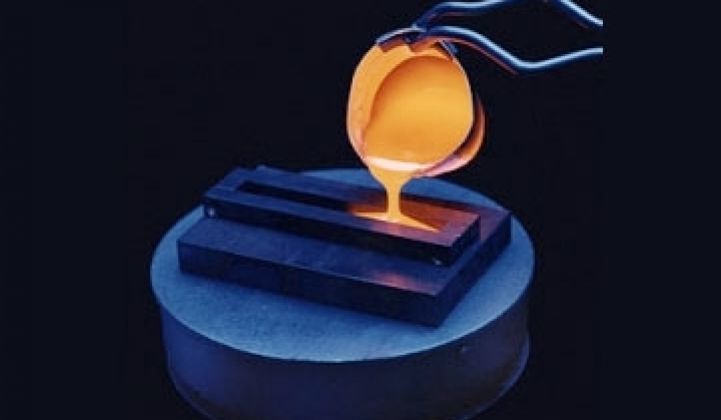Kurion, a startup that wants to make vitrification a major prong in the nuclear waste disposal strategy of the U.S., came out of stealth today by providing some information about its technology and announcing news of a testing contract with CH2MHill.
Vitrification involves sealing nuclear waste into a glass matrix to prevent it from leaching into the environment or leaking from container cylinders. (See earlier story on Kurion here.) The key is that Kurion's technology is modular, which, ideally, will reduce the costs and onerous construction times. While Japan and a few other countries have embraced vitrification, the U.S. stores nuclear waste in steel cylinders that are submerged into pools to contain it and cool it off. When these pools reach capacity, cylinders that have sufficiently cooled can be removed and stored above ground. The U.S. has experimented with vitrification for years and planned to use some form of vitrification at the Yucca Mountain site. It has even looked at the "synthetic rock" process developed in Australia. But with Yucca Mountain stuck in a permanent state of limbo, nuclear waste from the United States remains stuck in tubs in places like Hanford, Washington.
Kurion said that it has created a test line of its modular vitrification system (MVS) and will begin a series of simulated tests in December. The company has also demonstrated internally its ion specific media technology for separating higher and lower activity streams. CH2MHill Plateau Remediation Company will evaluate the use of MVS to encapsulate uranium metal bearing sludges that are presently stored at the Hanford K-Basins spent fuel pool.
Potentially, if Kurion can prove its technology, it could have a slightly easier time getting to market than the modular nuclear reactors proposed by NuScale Power, Terrapower and other startups. All of these companies will have to run a gauntlet of public interest and regulatory hearings. Additionally, the reactor startups ultimately have to sell their technology to utilities, which in turn would have to raise billions to build modular, gigawatt-scale power plants with these reactors. Even conventional nuclear plants are experiencing difficulty getting capital these days.
Kurion essentially only has a more attractive end-user in mind: the federal government, which oversees the U.S. nuclear stockpile. Engineering companies like Bechtel and CH2MHill will technically buy the technology but the federal government ultimately foots the bill and decides what techologies will get used. The feds have searched for a solution for years. Lux Capital and Firelake Partners are Kurion investors.
Kurion's management includes experts from both the nuclear and glass industries. The CEO is John Raymont, the former CEO of Nukem, an unfortunately named company that provided nuclear waste management services for 25 years before being acquired in 2007 by EnergySolutions. The vice president of technology is Gaetan Bonhomme, a former senior research engineer at French glass and industrial giant Saint-Gobain. Josh Wolfe, from Lux, is the chairman.
The advisory board includes Patrick Moore, the Greenpeace founding member turned nuclear advocate. Moore is the co-chair, along with former New Jersey Governor Christine Todd Whitman, of the Clean and Safe Energy Coalition, a lobbying group for the nuclear industry.
The other solution for nuclear waste that the U.S. has yet to embrace is reprocessing, which has always been something of a hot potato in the country. In 1956, Lewis Strauss, then-chairman of the Atomic Energy Commission (a forerunner to the Nuclear Regulatory Commission), proposed reprocessing, and Davison Chemical Company began negotiations to reprocess fuel with the commission at the time. The company, which changed its name to Nuclear Fuel Services, reprocessed waste from weapons programs in the late '60s, but not from commercial nuclear reactors. It shut down operations in 1976.
General Electric proposed reprocessing commercial nuclear waste in the 1960s, but gave up on the idea in 1972. Exxon looked into it in 1976, but then, on October 28 of that year, President Ford announced that:
"The reprocessing and recycling of plutonium should not proceed unless there is sound reason to conclude that the world community can effectively overcome the associated risks of proliferation."
Jimmy Carter, himself a nuclear engineer, followed up with an indefinite ban. Thus, although Carter often gets the blame for putting the kibosh on reprocessing, Ford had already cast it largely to bureaucratic oblivion and the private sector had registered its doubts years before. There's your nuclear history moment for the day.



